Deck vulnerabilities

Decks can be ignited by wildfires via flame contact (usually from below) or ember attack (usually from above). Burning decks will expose the house to long-term flame impingement, which could ignite siding and eaves, and/or shatter windows. There are several factors that can contribute to deck ignition. Embers could ignite combustible materials stored or accumulated under the deck, exposing the rest of the deck to flame contact. Embers could also accumulate in gaps between deck boards and ignite debris. If the deck is in contact with vegetation or other combustible materials, they could provide a direct fire path causing deck ignition. A non-combustible surface or structural component is not always enough to prevent ignition.
How can you protect your deck?
Deck enclosing is often recommended by wildfire guides, but it may not always be the best option. The benefits of enclosing your deck are minimal if you are not storing combustible materials under your deck, while moisture-related degradation can become problematic. The gaps between deck boards also play an important role in ignition. A gapped-board deck will be less likely to have flames spread from its lower to upper surface if the deck boards are tightly installed. It would, however, be a bad detail due to the increased risk of water accumulating in the joints, causing fungal decay. The deck's distance from the ground also matters. Debris under decks that are close to the ground are generally more difficult to remove and could pose a fire safety risk.
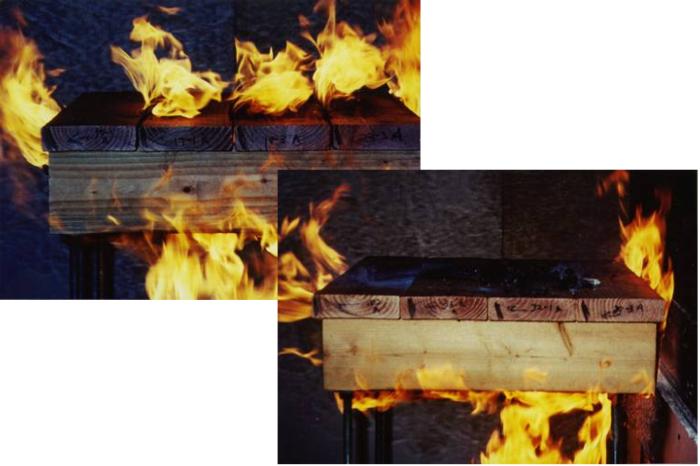
These are general guidelines to make your deck more fire resistant:
- If your deck is made of combustible materials (like wood), is there anything that needs to be repaired (rotting or chipped parts)? Replace any damaged sections since they may easily ignite during a fire
- Are the gaps between deck boards free of debris? When exposed to embers or flame impingement, accumulated debris may ignite. Maintain the underside of your deck clean from debris
- Is there any combustible material (flammable siding, furniture, or vegetation) near the deck (top, bottom, sides)? Create a vertical and horizontal clearance between deck and vegetation, and rearrange other combustible items away from vulnerable locations (in order to secure your deck surroundings, check recommendations about defensible space)
- Do you have an enclosed deck? Are the vents and drains fire resistant? The enclosure and the vents should be able to stop embers from flowing through them (see the vents section)
- If you have time before evacuation, bring combustible door mats, brooms and furniture cushions inside. Move deck furniture off the deck. Move barbecue propane tanks away from the house
- For new installations with untreated wood, the deck fire resistance could be improved by: 1) increasing the gap between deck boards from 1/8” to ¼”; 2) increasing joist spacing from 16” to 24”; 3) applying a foil-faced self-adhering adhesive flashing tape (foil-faced bitumen tape) on the top of each joist. Foil tape should extend down each side of the joist 2-3”
Examples of decks
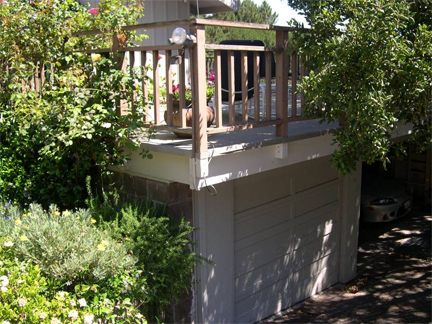
|
Vegetation close to deck. Embers could ignite objects on top of the deck. More importantly, the surrounding vegetation could ignite the siding. It is recommended to trim the vegetation around the deck (within 5ft at least). |
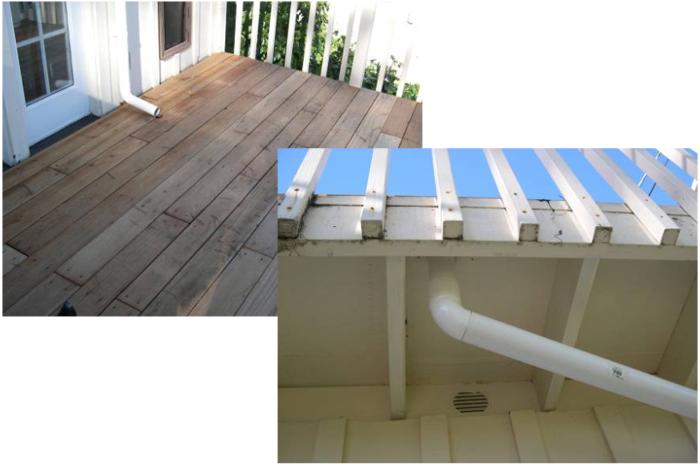
|
Deck with membrane. The deck boards are attached to 2’ x 4’ sleepers that rest on a waterproof membrane attached to the sheathing. The top of the deck is clear of combustible materials. The deck-to-wall areas, as well as the siding framing, should be maintained in good conditions and clear of combustible materials. |
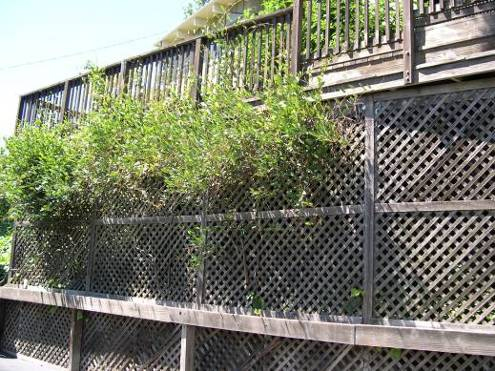
|
Deck enclosed with lattice fencing. The wood of this deck is aging and in close contact with vegetation, therefore this deck is at high risk. Embers can easily pass through the lattice fence and ignite the bottom. Under-deck vegetation and lattice fencing should be removed. The deck could be enclosed with noncombustible panels. |
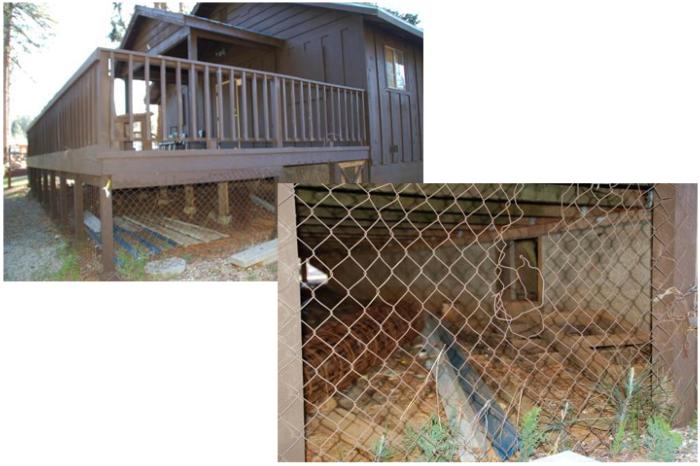
|
Deck with chain link fence. This type of fence allows debris and embers to pass through. The combustible materials stored below the deck should be removed. The under-deck area should be kept clean. |
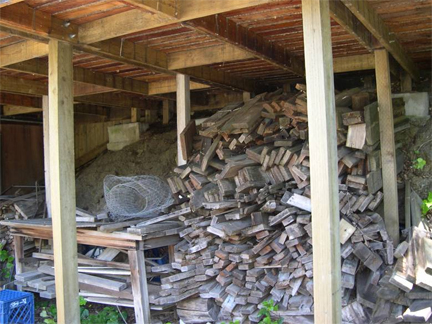
|
Deck with storage underneath. This deck area is extremely vulnerable to ignition due to the construction materials accumulated under it. A vertical enclosure of the deck would be appropriate if storage space is needed. Solid surface membrane-decking would provide an added benefit here. |
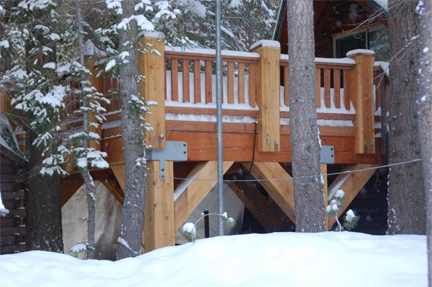
|
Deck with heavy timber structure. The size of the timber used for this deck makes it very resistant to ignition. Keep both top and bottom of the deck clear of combustible materials. |
California regulations
Chapter 7A predominately addresses the deck surface (deck boards, rails, treads, etc.), and not the underlying structural support members. It does not require enclosing the deck. Chapter 7A assumes that you have created an acceptable defensible space around your home or building. This includes the area under the deck.
When reviewing decking information in the WUI Products Handbook (or elsewhere), note how the product complies. Detailed information about the different compliance methods is provided below.
Compliance with Chapter 7A can be achieved in three ways:
- Satisfy all the acceptance conditions of the SFM 12-7A-4 test (both Parts A and B). Part B uses type ‘A’ burning brands. Decking materials that comply with this option must also be ignition-resistant.
- The deck consists of (i) heavy timber construction (as specified in California Building Code Section 605.6), (ii) exterior-rated fire retardant treated lumber (this product qualifies as an ignition-resistant material) or (iii) approved noncombustible materials (such as metal deck boards or lightweight concrete surface).
- This is a variation of #1, but it is less restrictive. Decking only needs to meet the minimum heat release rate requirement of Part A. Three criteria for Part A don't apply (self-extinguishing, dropping flaming debris, and structural failure). Brand testing (Part B) is also not required. Products that comply with this option should also provide flame spread rating information (Class A, B, or C). Unless you can find it, assume Class C. In this case, the exterior siding within 10 feet of the deck must be either noncombustible or ignition-resistant (untreated wood siding, vinyl siding, and other combustible sidings cannot be used). For Class A and B flame spread ratings, siding that complies with Chapter 7A can be used. In most cases, deck boards are compliant with this option.
San Diego County has a different requirement for decking. It is more restrictive than the third option but less restrictive than the first (uses ‘B’ brand instead of ‘A’ brand for the burning brand exposure).
Since currently the State doesn't require marking the edge of the deck boards to show compliance while San Diego County does, markings similar to the ones shown in the picture below will indicate compliance in San Diego County.

As part of a fire demonstration, a burning 'B' brand was placed on both of these decks. The photograph was taken approximately 60 minutes after the burning brands were placed on the decks. The decking product on the left does not comply with the provisions of Chapter 7A. The decking product on the right does comply. Since Chapter 7A only applies to new construction (those buildings constructed since January 2008) and not to new decks built on older homes, both of these products are commercially available.
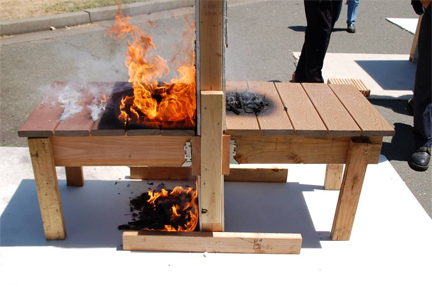
Products and assemblies that have complied with Chapter 7A can be found in the WUI Product Handbook. Since “ignition resistant” and “non-combustible” are performance-based characteristics (i.e., there is a standard test to show compliance), these materials are included in the Handbook.
Check out these additional wildfire preparedness resources from UC ANR Fire Network Members and our colleagues!
Decks
- Hedayati et al., Evaluating Deck Fire Performance—Limitations of the Test Methods Currently Used in California’s Building Codes, Fire, 2022
- Hedayati and Quarles, Performance of Attached Decks Subjected to Ember Top-of-deck and Flame Impingement Under-deck Exposures, 2022
Home Hardening